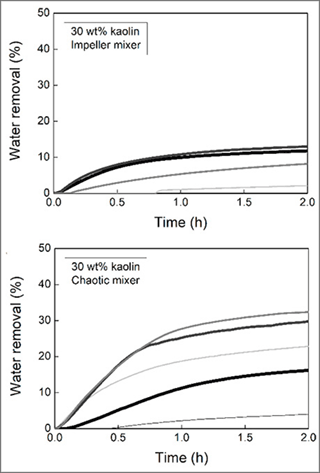Monitor - ISSN 1472-0221
The Newsletter for Data Acquisition and Control
Issue 261 July 2020
Hello and thank you for subscribing. I hope this email finds you safe and well.
You can download a pdf copy of this newsletter here.
Contents
* Increasing storage safety after mineral extraction
* Your DAQ Questions Answered
* Data Acquisition News Round-Up
Increasing storage safety after mineral extraction
Web link: https://www.windmill.co.uk/tailings-water-extraction.html
When companies extract minerals from the ground, they are generally left with a liquid slurry made of fine particles and water - "tailings". This creates the problem of storage. Excess water in the tailings can lead to a disaster. For the tailings to be safely stored, the water needs to go.
Scientists from Australia's national science research agency, CSIRO, are investigating methods of more efficiently extracting the water, and are using Windmill software to measure the expulsion of liquid under different conditions.
Injecting polymer additives can accelerate the water recycling. Led by Allan Costine, the team used a clay suspension to study the effect of different proportions of polymers. They pumped the clay suspension and polymer solution into a mixing vessel. They tested two types of mixer - a chaotic or topological mixer and a pitched blade turbine mixer - to produce flocculated solids with vastly different dewatering properties.

When a stable mixing state was reached, the scientists collected a sample of the conditioned suspension and ran the Windmill data logging software to record the mass of water expelled every minute. They continued to log data for 24 hours, with most of the recoverable water collected in the first two hours. Comparing different polymer solutions and mixing methods, the research team highlighted methods to markedly improve water recovery - thus protecting the environment, improving safety and reducing costs
Further reading
Costine, Allan; Fawell, Phillip; Chryss, Andrew; Dahl, Stuart; Bellwood, John. Development of Test Procedures Based on Chaotic Advection for Assessing Polymer Performance in High-Solids Tailings Applications. Processes. 2020; 8(6):Article 731. https://doi.org/10.3390/pr8060731
Your Data Acquisition Questions Answered: ComDebug
Question
I've upgraded ComDebug, but it has different options for the timings. We used to use "Continuous Flow". Which option should we use in the newer version?
Answer
For instruments that continuously send stream of data without any intervention, use Read in Background. Make sure that the Instrument Timeout and Data Persistence Time are set to longer than the rate at which the instrument sends messages. The Instrument Timeout sets how long ComDebug should wait for a reply from the instrument before giving up. The Data Persistence Time sets how long data should remain valid. For more information press the ComDebug Help button and see More about Instrument Timings.
Anyone wanting to download ComDebug, the software to collect data from devices communicating over Modbus, TCP-IP and RS232, may do so from https://www.windmill.co.uk/serial.html. Any questions, e-mail monitor@windmillsoft.com.
DAQ News Round-up
Welcome to our round-up of the data acquisition and control news. If you would like to receive more timely DAQ news updates then follow us on Twitter - @DataAcquisition - or grab our rss feed.
Crop infesting spores 'tricked' by new biomaterials to aid global wheat production
Networks of cheap disposable in-field biosensors detect the infections of crops at the earliest signs. The new sensor can identify the exact conditions for when spores turn from benign particulates to serious diseases.
Source: University of Manchester
https://www.manchester.ac.uk/
Flood Bot: Scientists develop new flood warning sensors
The Flood Bot sensors detect and monitor water levels in rivers as well as other information about weather, rainfall and water levels at other nearby locations.
Source: University of Maryland
https://news.umbc.edu/
From humble hair to high-tech water sensor
Researchers have used human hair waste to develop sustainable organic hi-tech devices for water quality testing of contaminants.
Source: Griffith University
https://news.griffith.edu.au/
New easy-to-read, color-changing sensors
Engineers have developed a way to stretch and strain liquid crystals to generate different colors which could be applied in sensors, and wearable electronics.
Source: The University of Chicago
https://pme.uchicago.edu/
Researchers print graphene sensors to monitor food freshness and safety
Researchers dipped their new, printed sensors into tuna broth and watched the readings. It turned out the sensors - printed with high-resolution aerosol jet printers on a flexible polymer film and tuned to test for histamine, an allergen and indicator of spoiled fish and meat - can detect histamine down to 3.41 parts per million
Source: Iowa State University
https://www.research.iastate.edu/
* Copyright Windmill Software Ltd
* Reprinting permitted with this notice included
* For more articles see https://www.windmill.co.uk/
We are happy for you to copy and distribute this
newsletter, and use extracts from it on your own web
site or other publication, providing the above notice
is included and a link back to our website is in place.
For previous issues by subject see https://www.windmill.co.uk/monitorindex.html
SUBSCRIBING OR CANCELLING SUBSCRIPTION Visit https://www.windmill.co.uk/newsletter.html and add or remove your e-mail address.
Windmill Software Ltd, PO Box 58, North District Office,
Manchester, M8 8QR, UK
Telephone: +44 (0)161 834 6688
Facsimile: +44 (0)161 833 2190
E-mail: monitor@windmillsoft.com
https://www.windmill.co.uk/
https://www.windmillsoft.com/
